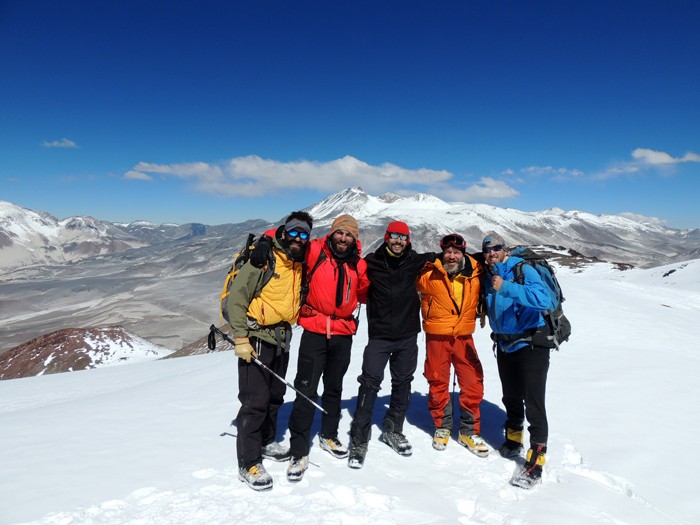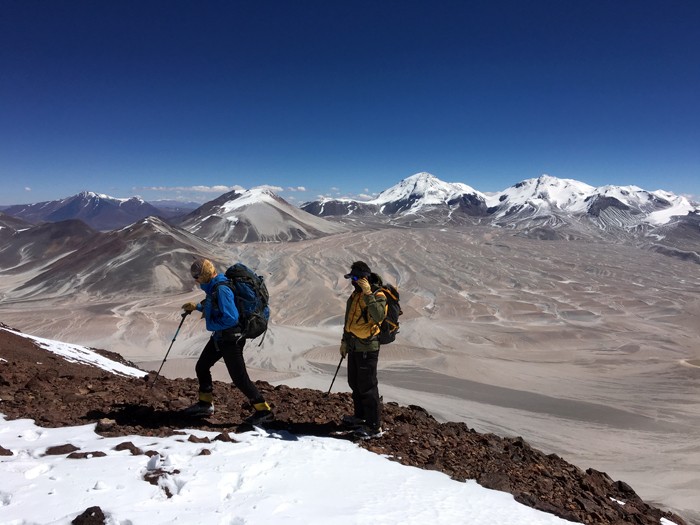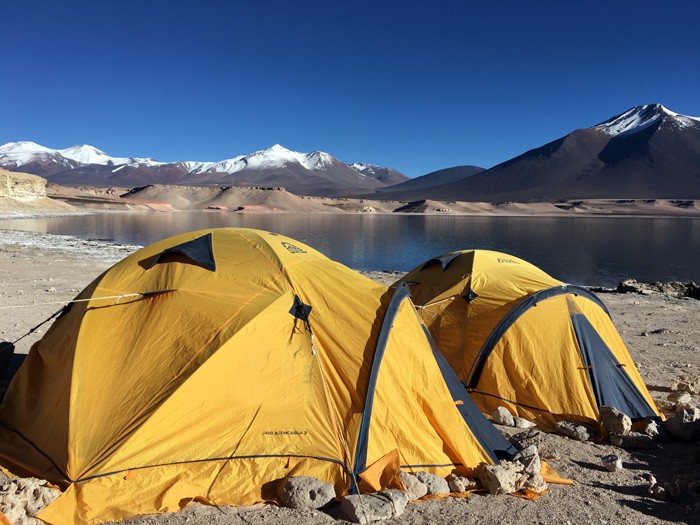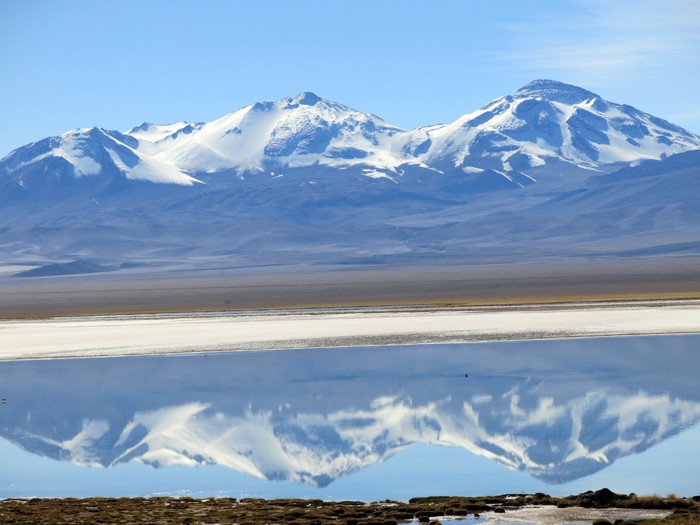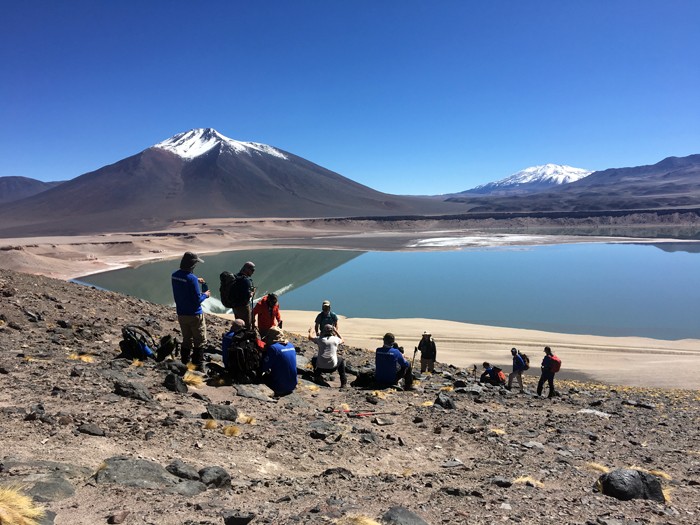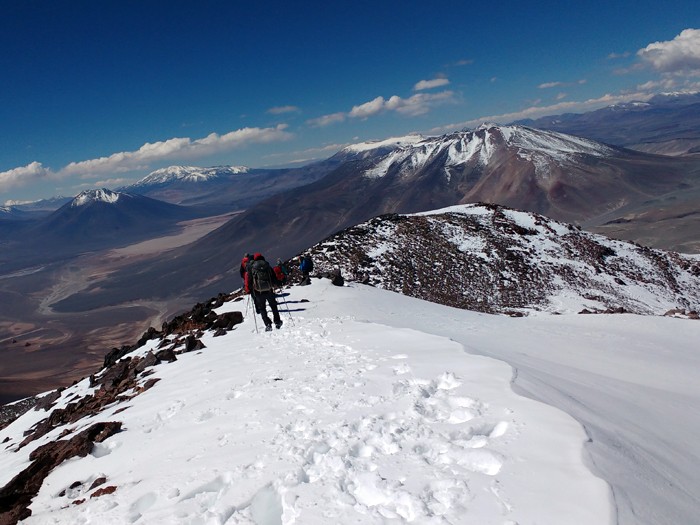Ojos del Salado Overview
Ojos del Salado is an active volcano in the Andes on the Argentina–Chile border and the highest active volcano in the world at 6,893 m (22,615 ft). Ojos del Salado could be translated as "Eyes of the Salty One", which describes it as being very snowy in the winter and salty with many lakes.
It is also the second highest mountain in both the Western Hemisphere and the Southern Hemisphere, only 68 metres / 223 feet lower than Aconcagua, one of the seven summits. At approximately 7,000 meters (23,000 ft), this climb is an excellent test of how you will perform at a very high altitude and very good preparation for climbing 8000 metre (26,000 ft) peaks such as Everest. The climb includes excellent leadership by SummitClimb’s leader Max, who has led more than 40 SummitClimb expeditions to Ojos, Aconcagua, Everest, Lhotse, Manaslu, Gasherbrum, Cho Oyu, Ama Dablam, Lobuche, and Island Peak. During our climb of Ojos del Salado the team will practice and refresh skills with rope technique and will acclimatize carefully by climbing several sub peaks, with rest days in between, before ascending Ojos itself. The trip also includes delicious food, nice hotels, very good basecamp with a cook, and all high altitude support staff, high camps, tents, meals, etcetera. Climbing Ojos is excellent preparation for Everest and other 8000 metre peaks.
Summit Description: In our expedition we climb the highest summit, which is the Chilean summit. The Argentine summit is 190 metres away from the highest in Chile. To get to the top of the Chilean Summit we indeed require everyone to wear a helmet, specially in the last section. For the last 8 years in a row we have summited Ojos and every single time we fixed ropes in the 3 potentially dangerous parts:
1 - Traverse at 6500 metres / 21,325 feet
The traverse at 6500 is a simple snow or hard snow traverse (rarely ice), and we do ask our clients to take an ice axe. It's a 100 to 150 metre traverse with little altitude gain. Although depending on conditions it might not even require an ice axe as our members may clip our fixed line and walk safely. So this section requires: Crampons, Helmet, Harness ( +1 safety carabiner and sling) and Ice Axe.
2 - Climb to col at 6850 metres / 22,474 feet
This is a straight forward climb. It's about 7 metres on pure rock with occasional snow patches. Because we start it on snow and it takes too long to take off crampons and put them back, our clients climb this section wearing crampons. It's a French class 3 rock, very easy climb and we fixed a rope line every time. No need to take ascenders as we normally have 2 or 3 guides belaying everyone in this section. This section requires harness + sling + carabiner and helmet. No ice axe needed here. If we have time, everyone can leave crampons at the bottom of this climb.
3 - Summit section at 6898 metres / 22,631 feet
This is the easier of the 3. It's only 20 to 30 metres and has little altitude gain. We fix a line in this area because although it is only a rock scramble, it's exposed and wind can take someone's balance here. When finished, you are on the top. Only harness and helmer required here.
Please note we run our expeditions at Ojos with maximum safety and we have summited every single time.
Ojos del Salado Cost
Included in Price
- Leader
- Assistant mountain guides (client per guide ratio = 2/3);
- Transport from/to airport;
- 2 nights in a 3 star hotel in Copiapo – the rooms are shared by each two expedition members
- 4×4 transport from/to Copiapo
- Usage of lodge at Laguna Santa Rosa;
- Usage of tents, dining tents, kitchen and kitchen utensils;
- Cook and staff at basecamp and approach camp;
- Usage of medical kit;
- All meals outside Copiapo;
- All climbing permits.
What is not included in the price
- Flights from/to Copiapo;
- Personal climbing equipment;
- International travel insurance;
- Lunch and dinner in Copiapo;
- Reimbursement for loss or damaged personal equipment;
- Extra nights in the hotel – price $59 per night
- You can upgrade to a single hotel room for the included nights at $130 and have a single tent for $250
Ojos del Salado Itinerary
- Day 1 – Arrival in Copiapó – 800m - We’ll greet you at the airport, approximately 50 km from Copiapó. On the same day, we’ll review your personal gear, make final adjustments, and shop for anything necessary. Tonight, enjoy our first group dinner and meet your teammates! Included: Transport, hotel
- Day 2 – Copiapó → Laguna Santa Rosa Hut – 3,700m - After a scenic 210 km drive, we’ll settle into a cozy mountain hut next to the stunning salty Laguna Santa Rosa. Included: Breakfast, transport, lunch, dinner
- Day 3 – Acclimatization on Siete Hermanas – 4,780m - Today we tackle Siete Hermanas! Depending on the group’s fitness level, we aim for the summit or go as high as comfortably possible to support acclimatization. Included: Breakfast, lunch, dinner
- Day 4 – Laguna Santa Rosa → Laguna Verde – 4,300m - After a generous breakfast, we’ll drive 120 km to our private basecamp at Laguna Verde. Our comfortable camp includes Starlink internet, a generator, dining tent, kitchen, toilets, and showers. Included: Breakfast, lunch, dinner
- Day 5 – Climb to Mulas Muertas – 5,200m - Another important acclimatization day climbing Mulas Muertas, situated close to camp. We’ll keep it relaxed, ascending comfortably without straining our bodies. Included: Breakfast, lunch, dinner
- Day 6 – Rest Day at Laguna Verde – 4,300m - Rest, recharge, and enjoy the beautiful views at Laguna Verde. Included: Breakfast, lunch, dinner
- Day 7 – Acclimatization to Tejos – 5,900m - We’ll drive up to approximately 5,900m, followed by a short hike reaching up to 6,000–6,100m. This crucial acclimatization ensures we’re ready for Nevado San Francisco and Ojos del Salado. Included: Breakfast, lunch, dinner
- Day 8 – Rest Day at Laguna Verde – 4,300m - Another day to rest and prepare mentally and physically for the climbs ahead. Included: Breakfast, lunch, dinner
- Day 9 – Nevado San Francisco Summit – 6,023m - After an early breakfast, we’ll gear up and drive 30 minutes to start our climb at 5,000m. This challenging yet rewarding climb via the north ridge takes around 5–7 hours. A successful summit boosts confidence and acclimatization for Ojos del Salado! Included: Breakfast, packed lunch, transport, dinner
- Day 10 – Rest Day at Laguna Verde – 4,400m - Rest and recover from yesterday’s climb, enjoying tranquility at Laguna Verde. Included: Breakfast, lunch, dinner
- Day 11 – Summit Ojos del Salado – 6,898m - Our ultimate goal! Starting around midnight, we embark on a 3-hour drive followed by a 7–9 hour ascent. We’ll traverse switchbacks, navigate a large traverse at 6,500m, reach the main crater, and conquer the final steep and technical section. Celebrate reaching the top of the highest volcano on Earth! Included: Opportunity of a lifetime!
- Day 12 – Return to Copiapó - Drive back to Copiapó and rest after our epic adventure. Included: Transport, hotel
- Day 13 – Extra Margin Day - Buffer day for unforeseen circumstances or extra recovery. Included: Breakfast, lunch, dinner
- Day 14 – Departure - Fly home, carrying memories of an incredible experience! Included: Hotel breakfast, airport transfer
Ojos del Salado Leadership
Ojos del Salado Equipment
Climbing:
- Ice axe with leash
- Steel crampons with anti-balling plates
- Trekking poles
- Harness -A good light alpine harness
Upper Body:
- 2 cotton t-shirts
- 2 synthetic t-shirts
- 2 long sleeve synthetic shirts
- Light-weight soft shell jacket
- Medium weight insulating jacket (fleece, down, or synthetic)
- Hard shell jacket with hood, waterproof and breathable (Gore-Tex or similar)
- Heavy down coat – must be large thick down jacket with hood
Hands:
- Lightweight poly-liner gloves
- Mid-weight soft shell gloves – water/wind resistant
- Heavy- weight waterproof gloves – Gore-tex shell with removable liner
- Expedition weight mittens -Gore-tex over mitt matched polar fleece mitt liner
- Hand warmers 1 or 2 packs -Chemical hand warmers for the summit push.
Head:
- Helmet
- Warm hat that covers your ears
- Balaclava
- Face mask
- Baseball hat or brimmed sun hat
- Glacier sunglasses with side shields
- Ski goggles with light and dark lenses
- Glasses with clear lenses to protect your eyes while climbing to the summit on windy nights. (cost less than 10 dollars in Kathmandu)
- Headlamp with extra batteries and bulbs
- Buff/neck gaiter
- Bandana or head scarf (optional)
Lower Body:
- Synthetic underwear
- Hiking pants
- 2 pair lightweight thermal bottoms
- Polar fleece or soft shell pants
- Waterproof/breathable pants with full side zips (Gore-Tex or similar)
Feet:
- Boots – a paid of double or double plastic boots such as Koflach Exped, Koflach vertical, Asolo Ottomilia, Asolo AFS, Trezetta, Scarpa Vega, Scarpa Inferno, La Sportiva Baruntse, Olympus Mons, La Sportiva Spantik, Scarpa Phantom, La Sportiva G2. Single layer boots such as La Sportiva Nepal XT, EVO, Batura or Boreal Latok are NOT suitable.
- Sturdy leather walking boots
- Sandals or crocs
- Down booties (optional)
- 3 pair med-heavy poly or wool socks
- 2 pair poly or wool liner socks (optional)
- Vapor barrier liner socks (optional)
- 4 pair lightweight trekking socks
- Cotton socks for in town
Sleeping:
- Down sleeping bag; -20C or -4F down sleeping bag (Comfort temperature)
- 2 closed cell foam kari-mats (sleeping pads) for use in basecamp and high altitude.
Rucksack and Travel Bags:
- Medium rucksack/backpack (50-70 litres / 3000-4500 cubic inches, can be used as carry-on bag)
- Waterproof rucksack cover (optional)
- 1 large (120+ L / 7500+ cubic inch) duffle kit bags for clothing and equipment
- Small luggage locks for duffel kit bags
Personal Hygiene:
- Female or male hygiene supplies
- 2 tubes lip sun cream
- Large tube skin sun cream (min factor 30)
- Anti-mosquito cream
- Toothpaste/brush
- Hand sanitizer gel (small-medium bottle)
- Bar of soap small towel
- Hand wipes
- Face Mask
- Hand sanitiser
- Disposable gloves
- Disinfectant wipes
Medical:
- Small personal first-aid kit. (Simple and Light) Aspirin, first-aid tape, plasters (band-aids), personal medications, etc.
- Blister repair kit
- 10 anti-diarrhea pills
- 20 Ibuprofen
- 10 cough and/or cold medicine
- Steri pen or bottle of water purification tablets
- Cough sweets/lozenges (Halls/Stepils)
- Earplugs
- Extra prescription glasses/contact lenses and supplies
Personal Food:
- Snacks 2kg Salty snacks, sweets, etc. Any sort of tasty ready food as complement. On high altitude mountains we don’t normally worry about vitamins and proteins as these kinds of food are too hard to digest. You can buy all these in a local market.
- 4 dehydrated meals (freeze-dried dinners) for the high camp.
- Carbo gels x 3 - These gels help out on recovery
- Small roll of repair tape
- Sewing repair kit
- Cigarette lighter
- Battery powered alarm clock/watch
- Camera with extra cards and extra batteries
- Nylon stuff sacks for food and gear storage
- 3 water bottles (1 litre) wide-mouth Nalgene
- Pee bottle (1litre or larger)
- Passport, flight ticket, flight itinerary
- Separate photocopies of passport and relevant visa pages, proof of insurance
- Dollars, pounds, or euros cash ($1800 in case you need a rescue and are not with Global Rescue)
- Bank/ATM/Cash and credit cards
- Paperback books, playing cards, ipod/mp3 player, musical instruments, extra batteries, etc.
- Travel clothes for basecamp and in town
- Small solar panels for personal electronics (optional) We already bring large solar chargers. Please avoid bringing AC chargers, please keep it DC(Car plug adapters or similar)
RENTAL PRICE LIST:
Please find the cost for rentals below. Please note these have to be paid in cash in Copiapo. Please send your rental requirements in advance so that we can prepare the items.
- Climbing Harness Aero Team IV Beal - USD 28
- Trekking Poles Forclaz MT500 - USD 14
- Helmet Mammut Skywalker - USD 37
- Helmet Camp Rock Star - USD 32
- Helmet Simond - USD 28
- Down Jacket Simond - USD 102
- Foam Mat Andesgear Ixpe - USD 19
- Foam Mat Doite Geowavy - USD 14
- Inflatable Mat Andesgear Paine - USD 28
- Semi-Automatic Crampons Grivel - USD 56
- Universal Crampons - USD 46
- Down Mittens Montane Alta - USD 56
- Down Mittens Rab Endurance - USD 46
- Mittens The North Face Himalayan - USD 51
- Mittens The North Face Nuptse - USD 42
- Ice Axe Black Diamond - USD 46
- Ice Axe Grivel 0 - USD 46
- Gaiters OR - USD 37
- Sleeping Bag Down Incahuasi -19 - USD 79
- Sleeping Bags Down Lippi Roca 7 - USD 79
- Boots La Sportiva G5 - for Mt San Francisco - USD 111
- Boots La Sportiva Baruntse - for Ojos del Salado - USD 134
- Boots La Sportiva Spantik - for Ojos del Salado - USD 134
Group Equipment: We provide group gear, equipment, and supplies including: rope, ice, rock, and snow anchor protection, tents; stoves, fuel, walkie-talkie radios, bamboo marker wands, etcetera. A personal tent will be provided for each member at base camp. On the upper mountain, team members will share tents. In base camp, a shower, toilet, solar charger, and a dining tent will be provided.
You can rent equipment in Copiapo. Please see the prices here
Ojos del Salado Experience and Training
Ojos del Salado Photo Gallery
Ojos del Salado Other Info
What are the Covid-19 precautions in place?
We will take the following measures:
- All our guides have to have Covid tests taken in Copiapo and/or vaccine if it exists/works by then
- All members and guides will be required to wear masks. This also helps with the dry air in the region which is one of the driests on Earth. So not only for Covid, everyone should wear mask and we do so for years already
- Each member will be given hand sanitiser to be used every time he or she is contact with food, other people, surfaces, or anything that might contain the virus
- During this climb each person will have 1 tent to avoid contact
- During lunch and dinner, we'll split the team in 2 or 3, so people don't sit close together
- We'll have quick rescue means in place in case someone has to leave the expedition. This way we can make sure any member is in a hospital within 4 hours from anywhere on the mountain.
- Other measures like private hotel rooms and 50% capacity on 4WD vehicles will be discussed
Will we be doing training on ropes, ice axe, crampons?
We have a training afternoon to make sure everyone's basic climbing skills are the same level. We might have clients from different backgrounds and different experiences. So we'll run this course.
Our skilful and friendly guides teach and review with you about how to use crampons, ice axes, helmets and to clip on fixed lines using carabiners.
How much money should we bring?
- Meals in Copiapo (average USD 150~200)
- Equipment rental - if any - has to be paid in cash
- Staff Tips (optional - normally our clients spend USD 200 on tips)
- Flights to Chile - From your country to SCL, then to CPO
- Rescue Insurance - Rescue Insurance - https://ss.globalrescue.com/partner/summitclimb/
- Extra Cash - Bring USD 400 in cash in case you need to leave the mountain fast
Ojos del Salado Application
Please fill out an application and return it to us with your refundable ten-percent deposit to hold your place on the team.
- Application for US Team Members : PDF Form or MS Word Doc
- Application for all other Team Members : PDF Form or MS Word Doc
In addition to your application, we will need the following at least two months before the trip begins:
- Completed Payment
- Oxygen order (if any)
- Sherpa order (if any)
- Trip Registration form
- 1 Passport sized photo
- A scan of your passport identification pages
- Complete flight itinerary
- Proof of travel, accident, and repatriation insurance. We strongly recommend Global Rescue, with at least $50,000 worth of helicopter rescue insurance.
- Trip cancellation/interruption insurance is recommended
Please contact us with any questions you may have.


